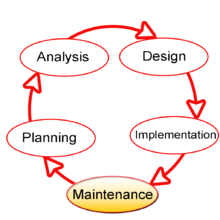Programming Fundamentals/Systems Development Life Cycle
Overview
[edit | edit source]
The Systems Development Life Cycle (SDLC) describes a process for planning, creating, testing, and deploying an information system. A number of SDLC models or methodologies have been implemented to address different system needs, including waterfall, spiral, Agile software development, rapid prototyping, and incremental.[1]
Discussion
[edit | edit source]The steps within the Systems Development Life Cycle (SDLC) explain how a computer information system that handles a major task is typically created. Information systems can be hardware based, software based (referred to as application software or applications), or a combination of both. Application software usually consists of many programs.
There are thousands of uses for an application to help improve and hasten a business, school, etc.. Real world deployment examples include: the Department of Defense supply system, the customer system used at your local bank, and the repair parts inventory system used by car dealerships. Another example would be the "101 Computer Games" available at some retail stores. This would be considered an entertainment application since the software actually consists of many different gaming programs (checkers, chess, tic-tac-toe, etc.). The code for each game was likely written by different programmers. Application generators are software that help programmers develop applications. These development tools have not been available until recently; they are helpful tools, especially for embedded software.
Computer professionals that are in charge of creating applications often have the job title of System Analyst. The major steps in creating an application include the following: planning, analysis, design, implementation, and maintenance. In the first step, the Planning phase, the System Analyst will identify if there is a demand for replacing or creating a new application. This is where a feasibility test is conducted to determine the success of the new application. During the Analysis phase, the desired operations of the application must be stated. This helps verify that the needs of the end-user are satisfied.[2] During the Design phase, the System Analyst will document the inputs, processing, and outputs of each program within the application. During the Implementation phase, programmers would be assigned to write the specific programs using a programming language decided by the System Analyst. Once the system of programs is tested, the new application is installed for people to use. As time goes by, things change and a specific part or program might need repair. During the Maintenance phase, it goes through a mini planning, analysis, design, and implementation cycle. The programs that need modification are identified and programmers change or repair those programs. After several years of use, the system usually becomes obsolete. At this point, a major revision of the application is done. Thus the cycle repeats itself.
Key Terms
[edit | edit source]- applications
- An information system or collection of programs that handles a major task.
- embedded software
- Software that is used for specialized technology that is typically not a computer, examples of this are the electronics of cars, telephones, modems, robots, appliances, toys, security systems, pacemakers, and electronic watches.
- implementation
- The phase of a Systems Development Life Cycle where the programmers would be assigned to write specific programs.
- life cycle
- How long an application lasts before it is replaced.
- system analyst
- Computer professional in charge of creating applications.
- Systems Development Life Cycle (SDLC)
- Planning – Analysis – Design – Implementation – Maintenance
